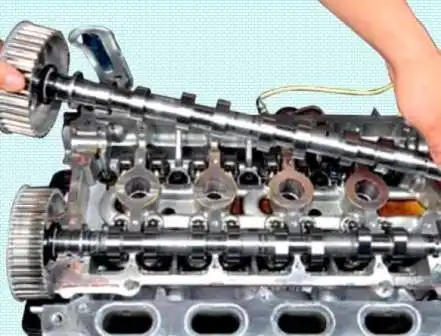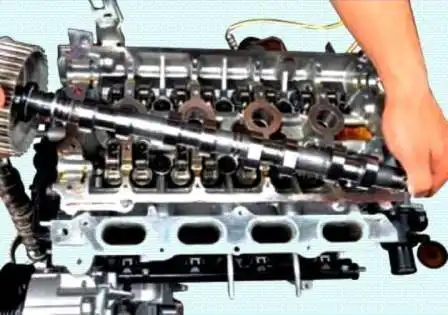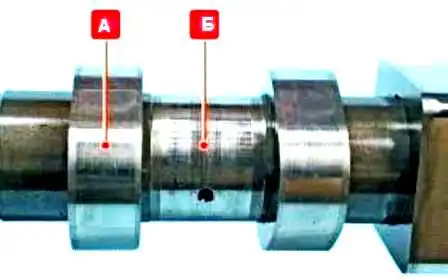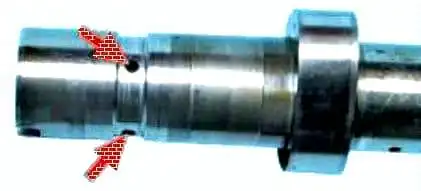The camshafts of the F4R and K4M engines are located on top of the cylinder head.
One shaft opens the intake valves and the other the exhaust valves
Eight cams are made on each shaft.
The design feature of the camshafts is that the cams are pressed onto the tubular shaft.
Camshaft beds (six bearings for each shaft) are detachable - located in the cylinder head and in the head cover.
Camshaft drive - toothed belt from the crankshaft pulley.
On each camshaft, on the side of the toothed pulley, a thrust flange is made, which enters the groove of the cylinder head, thereby preventing axial movement of the shaft.
The camshaft pulley is not fixed on the shaft with a tight fit, key or pin, but only due to the friction forces that occur on the end surfaces of the pulley and shaft when the pulley fastening nut is tightened.
The toe of the camshaft is sealed with an oil seal, put on the neck of the shaft and pressed into the socket formed by the surfaces of the cylinder head and the head cover.
To remove the camshafts, you will need tools: wrenches for 8, 10, 13, 16, sockets for 10, 16, 18, 17, Torx E14, Torx T8, Torx T14 wrenches, bronze drift, engine support, clamp for TDC setting, camshaft retainer.
Preparing the car for the task.
Release the pressure in the power system (article - Replacing the Renault Duster additional fuel filter)
Disconnect the negative battery terminal
Draining the coolant from the cooling system Renault Duster engine coolant replacement
Removing the accessory drive belt Renault Duster accessory belt
Remove the timing belt as described in the article - " Checking and replacing the timing belt of a Renault Duster car»
Disconnecting the exhaust pipe from the exhaust manifold (article - Removing the elements of the Renault Duster exhaust system)
Removing the receiver (article - Removing and installing the Renault Duster engine receiver)
Removing the cylinder head cover (Removing the Renault Duster cylinder head cover)

Remove the exhaust camshaft

Remove the intake camshaft

Inspecting the camshafts for wear and defects

The surfaces of bearing journals "B" and cams "A" must be well polished and without damage.
On the working surfaces of the necks, scuffing, nicks, scratches, aluminum enveloping from the bearing seats in the block head are not allowed.
If traces of seizing, overheating, deep scratches or wear in the form of a cut, as well as uniform wear of more than 0.5 mm, are found on the working surfaces of the cams, the shaft must be replaced.

We thoroughly clean the oil supply channels from deposits.
Camshaft lobes must not be ground to eliminate stepped wear, as changing the size of the cam profile will disrupt the valve timing.
Checking the radial runout.
If the runout is more than 0.02 mm, the shaft must be replaced, since its editing is not allowed.
Install the shafts in reverse order.
When installing new shafts, it is recommended to install new valve levers.
You can also see the article - " Removing camshafts and hydraulic valve bearings Renault Duster"





